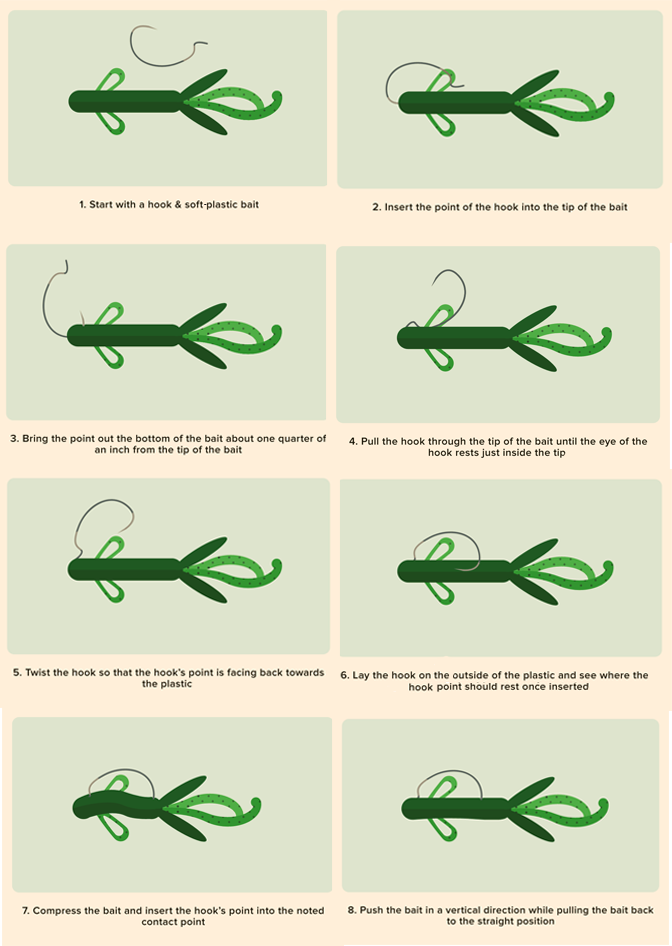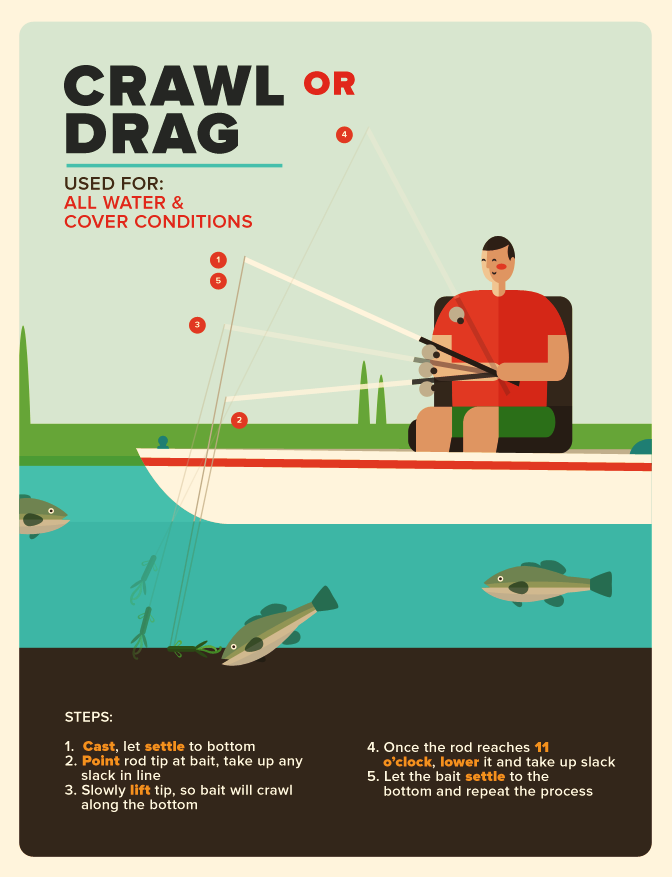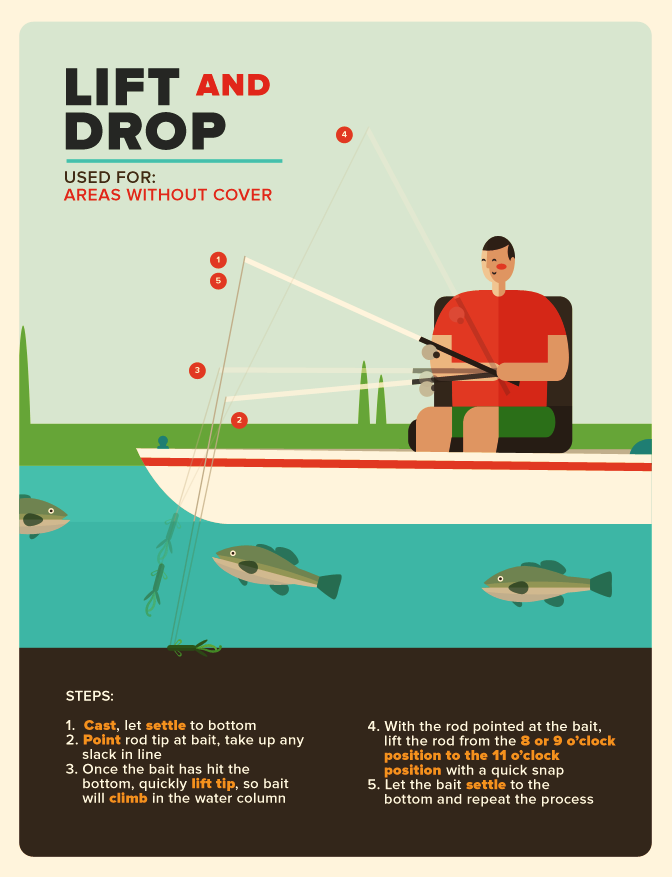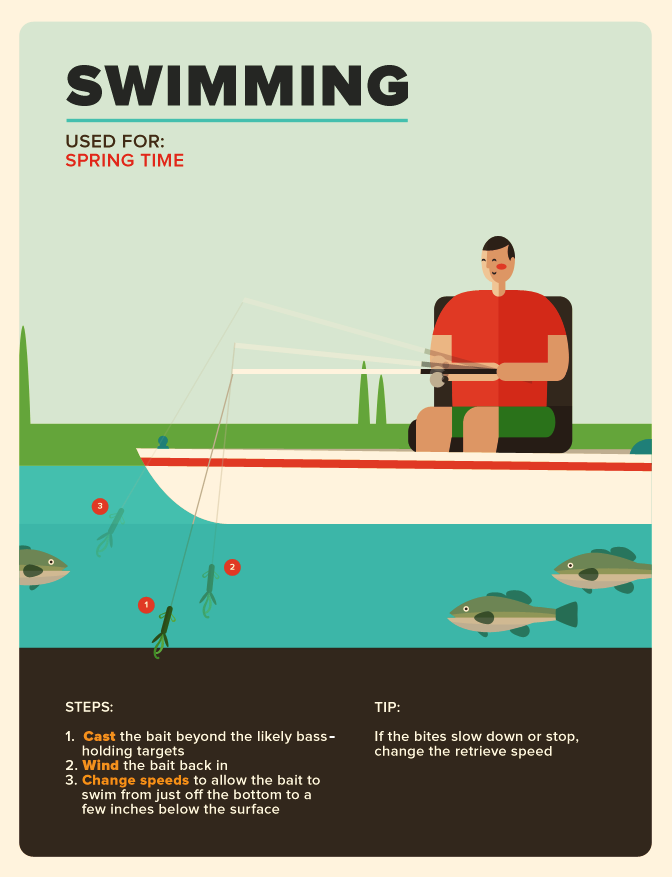Mastering the Texas Rig
Everything You Need to Know About Texas Rigging for Bass Fishing
Soft-plastic baits consistently catch bass in all water types and conditions. Whether the goal is to catch a bunch of bass, or the bass of a lifetime, the Texas-rigged soft-plastic bait is a great choice. However, the soft-plastic bait is probably the most difficult bass lure to understand. The variety of baits available, the numerous ways to rig them, and the fact they will catch bass in all water types and depths can leave an angler puzzled about exactly which choice to use. Some rigging methods being discussed in fishing circles include drop shotting, split shotting, darter heads, jig heads, the Carolina rig, and dozens more. Thankfully, the Texas rig will support all water types and cover situations. All plastic baits, worms, lizards, and creature baits can be rigged Texas style and be just as effective at catching bass as any other rigging style. The Texas-rigged soft plastic is the most weedless or snag-proof of all rigging methods, and can save anglers from the frustration of losing lures.
Step-by-Step
The Texas-rig assembly starts with putting a slip sinker on the line. To improve the weedless capability of the presentation a bullet-shaped weight is commonly selected. The line is inserted through the pointed end; this allows the pointed shape of the bullet weight to guide the bait through cover. Bullet weights are available in a variety of materials; lead and tungsten being the most common. I personally like tungsten weights for a smaller profile in the same weight class.
Next, tie a hook to the line. Hooks come in a great variety of shapes and sizes. I recommend an offset version around a 3/0 size. This size and shape will handle all soft-plastic baits and provide the hooking power necessary to catch any species of bass. The offset style is recommended for its bait-holding abilities; the hook shaft on an offset hook has a 90-degree angle that holds the soft-plastic offering in place, preventing smaller fish and weeds from diminishing its weedless characteristics.
With a weight and hook attached to the line it’s time to rig a soft-plastic offering. First step is to select a soft-plastic bait; this could be a worm, lizard, or creature bait. The bait style does not matter since the rigging process is the same. Some soft-plastic baits have a top and bottom; determine if yours does by looking for a flat side – the flat side is the bottom. To Texas rig a soft-plastic bait, insert the point of the hook into the center of the tip of the bait and bring the point out the bottom of the bait about one quarter of an inch from the tip of the bait. (Note: some baits are completely round and won’t have a top or bottom side, with these baits the exit point does not matter.) Continue pushing the hook through this section of the bait far enough to safely grab the hook shank. Holding the hook’s shank, pull the hook through the tip of the bait until the eye of the hook rests just inside the tip of the bait. Holding the section of the bait that the hook passed through, twist the hook so that the hook’s point is facing back towards the plastic.
To finish the rigging, lay the hook along the outside of the plastic and determine where the hook point should rest once inserted into the plastic. With the hook lying on the bait, make a mental note of where the hook’s curve lays against the bait. This spot will be used to correctly rig the bait. Now, compress the soft plastic bait towards the hook eye and insert the hook’s point into the noted contact point. Insert the hook point into the bait and push it in a vertical direction (towards the hook eye) while pulling the bait back to the straight position. Continue pushing the hook point into the bait until the hook’s barb is inside the soft plastic. The bait is correctly rigged when the hook’s barb is inside the plastic, yet the hook’s point did not come out the opposite side of the bait, and the bait is straight. With the cone shape of the bullet weight and the hook point concealed, this set-up creates a weedless bait that will prevent the majority of hang ups.
While the Texas-rigged soft plastic is a great tool for anglers, if incorrectly rigged it can create several problems. There are two primary concerns when setting up a Texas rig: first, the bait should be straight after rigging, this prevents line twist; second, the hook point and hook barb need to be completely covered by the bait, this prevents hang ups.
NOTE: The bait is correctly rigged when the hook’s barb is inside the plastic, yet the hook’s point did not come out the opposite side of the bait, and the bait is straight.

Presenting the Texas Rig
Texas-rigged soft plastics are very effective at catching bass in a variety of water and cover conditions. There are as many different ways to fish a Texas-rigged soft-plastic bait as there are anglers casting them. When first starting out, keep presentations simple using one of these three methods.
Crawl or drag: Used for all water and cover conditions, cast the bait and let it settle to the bottom. Point the rod tip at the bait and take up the slack in the line using the reel. Using just the rod, slowly lift the tip of the rod so the bait will crawl along the bottom. Once the rod reaches the 11 o’clock position, lower it and reel up slack line and repeat this process. If performed correctly you will feel the bottom of the lake as you lift the rod. If not, the lift needs to be slower.

Lift and drop: When fishing areas that are void of cover the lift and drop method is very effective and will allow you to cover a lot of water on a single cast. It is performed exactly like the crawling method with one exception – speed. The goal with the lift and drop is to lift the bait off the bottom one to two feet and let it fall back to the bottom. This is done by casting the bait and letting it settle to the bottom; however, instead of slowing lifting the rod to allow the bait to drag across the bottom, quickly lift the rod so the bait will climb in the water column. With the rod pointed at the bait, lift the rod from the eight or nine o’clock position to the 11 o’clock position with a quick snap. Let the bait settle to the bottom, take up any slack line, and repeat.

Swimming: Swimming a soft-plastic presentation can be very effective in the spring. As the water warms bass become very aggressive and fatten up for the coming spawn, during which they will not feed. Using soft-plastic baits with curly tails or appendages, cast the bait beyond likely bass-holding targets and wind the bait back in. This requires some experimenting to find the exact speed that is most appealing to the bass. Change speeds to allow the bait to swim from just off the bottom to a few inches below the surface. If the bites slow down or stop, change the retrieve speed to find the new aggression level of the bass. This aggression level can change throughout the day depending on the conditions.

Texas Rig Equipment
The type of fishing line used with this presentation is determined by the water conditions and cover. When fishing in lakes that have relatively clear water and very little vegetation or cover, using a monofilament line will be sufficient. In waterways that have abundant vegetation or cover, using an abrasion resistant line such as fluorocarbon or braided line is recommended. To break this down a little further, if the water is dingy, whether cover is present or not, use braided line. Braided lines have zero stretch; this translates to instantly feeling a bass strike the bait. Braided lines above 40-pound test are also very strong, thus reducing the risk of breaking when fishing in heavy cover. The only drawback to braided lines is the visibility in clear water and anglers believe that bass can see this line, preventing them from striking. Conversely, when fishing clear water, the fluorocarbon lines are recommended; they have minimal stretch and are virtually invisible underwater.
Because the hook point of a Texas-rigged soft-plastic bait is buried in the middle of the bait, a rod has to have the power to push the point through the bait and into the bass’s mouth when a hook set is performed. Bass fishing rods come in a variety of actions ranging from light to heavy and several combinations in between. Most anglers find a Medium-Heavy-action rod provides plenty of power for setting the hook and is best suited for Texas-rigged soft plastics. A rod’s tip speed is also a consideration – this is the rod’s ability to load up and cast baits. A tip action that is too fast hampers casting distance, if it is too slow, accuracy will suffer. A fast action is universal and will provide proficient casting with a variety of weights. The length of rod used for Texas-rig fishing varies by angler. I always recommend anglers purchase the longest rod that feels comfortable to them. A rod in the seven-foot to seven-foot four-inch range will provide effective leverage when battling big bass in and around cover.
Both baitcasting and spinning reels are effective with the Texas-rig presentation. Most anglers prefer the baitcasting option because these reels have higher gear ratios and take up line much quicker. The real advantage comes when a bass strikes; often a bass will strike a soft-plastic presentation and swim toward the angler. This creates slack line and prevents a solid hook set, giving the bass an advantage. The faster gear ratios put the advantage back in the angler’s hands because the faster reel will take up line very quickly and keep it tight.
Determining the weight to use is pretty simple, and mostly trial and error. The general rule is the deeper the water, the heavier the weight. This gets the Texas rig to the bottom quickly. For shallower water a smaller weight can be used. The cover being fished can also play a factor. If fishing heavy cover, a heavier weight can help get the bait deep into that cover where the bigger bass are hiding. Lastly is wind. On very windy days a heavier weight may be needed to help keep the bait on the bottom. Wind can put a bow in the line and if the weight is too small the wind could drag the bait with that bow. With this presentation, maintaining contact with the bait is vital to determining strikes. Use weight to help achieve constant contact. A general rule is to use the lightest weight possible to maintain constant contact with the bait for the given conditions.
Catching bass with soft-plastic baits is a lot of fun. During a retrieve you feel the rocks and sticks at the bottom, visualizing what your bait is doing, then suddenly there is a strange tap. That tap is the telltale signal you have fooled a bass and it’s time to set the hook. I find that when I’m fishing a Texas-rigged soft-plastic bait my senses are heightened and everything from the strike through to landing a bass is very exciting. Pick up some soft-plastic baits before your next outing, practice the Texas-rigging style, and get out and catch some bass.
Embed the article on your site

